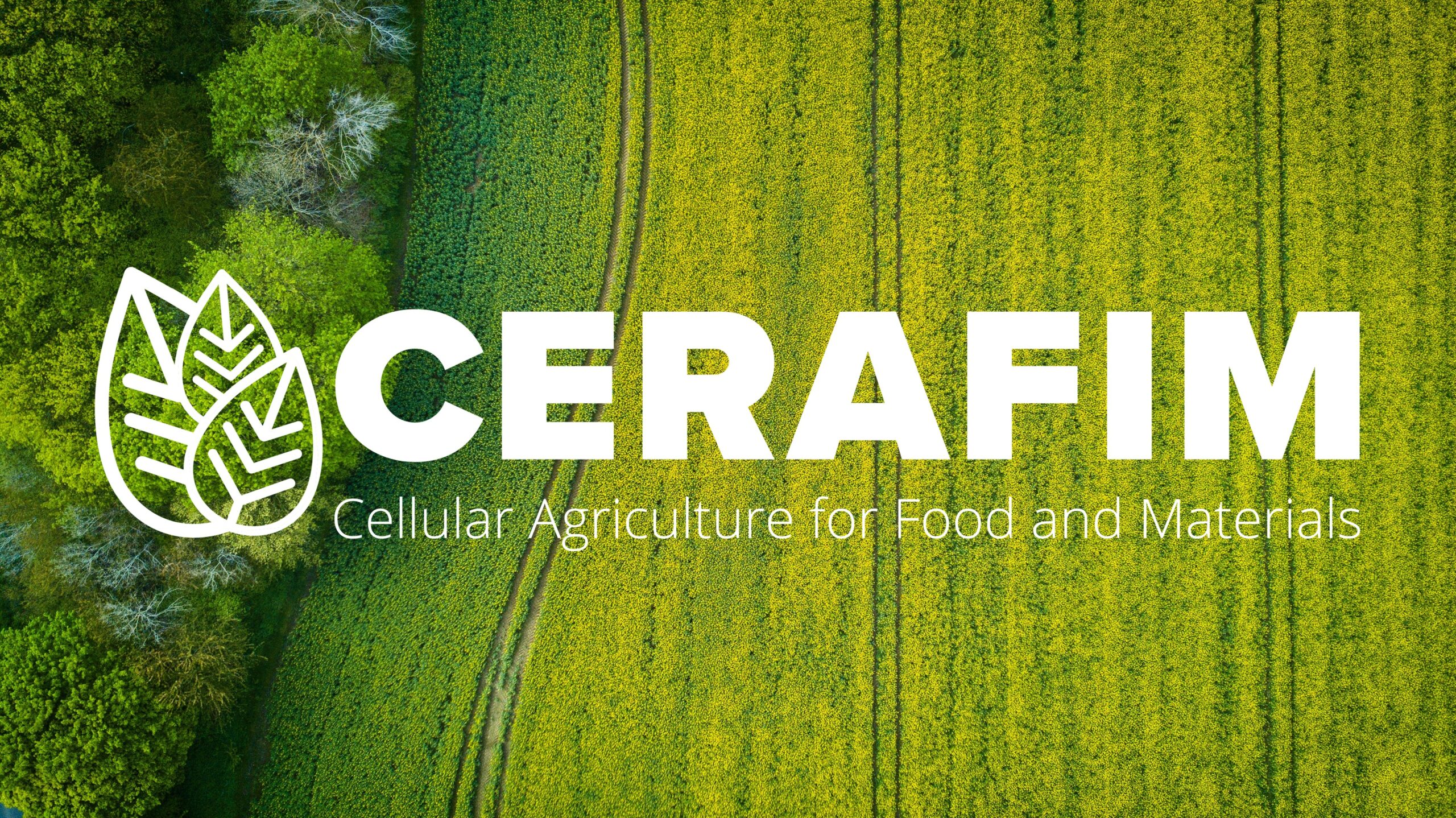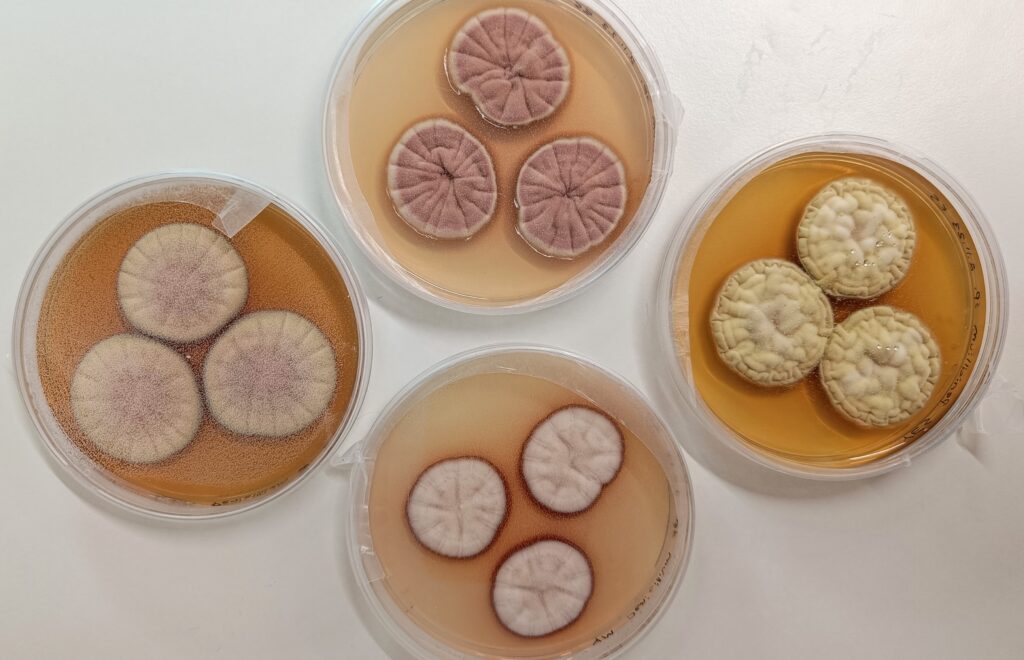
CERAFIM project explored the breakthrough potential of the emerging Finnish cellular agriculture ecosystem as one of the forerunners in green transition and circular economy
ProjectsBusiness Finland funded co-innovation project CERAFIM (Cellular Agriculture for Sustainable Food and Materials) focused on assessing the vast capabilities of cellular agriculture as a key enabler for reduced emissions from food and materials production and improved overall utilization of side streams from agriculture, forestry and food processing. Key examples of the innovative future concepts explored by CERAFIM partners included the production of silk protein with filamentous fungi Aspergillus oryzae, manufacturing cocoa butter equivalents extracted from yeast cells and creating mycelium leather from filamentous fungi biomass. The project’s key vision was that by 2030 European consumers will accept cellular agriculture as one of the mainstream methods of food and material production.
To reflect on the ended project and to discuss its highlights in more detail the ExpandFibre team was joined by CERAFIM project coordinator Dorothee Barth, Senior Scientist at VTT, in addition to industrial partners from the CERAFIM consortium represented by Dilek Ercili-Cura, Senior Research Scientist at Valio, Joosu Kuivanen, Co-Founder and COO at Enifer, and Matti Sonck, Development Manager, Bio2X at Fortum. Please note that after CERAFIM ended, Fortum sold its biobased business (Bio2X) to Chempolis Oy and Bio2X’s work continues now at Chempolis (Press release Sep 23rd, 2024).
Highlights from the project
To kick things off Dorothee was very happy to look back at the work that had been carried out during the past two years together with the CERAFIM partners: “We had four distinct work packages in the project exploring various topics starting from side stream utilization for synthetic biology, creating food and material concepts, characterizing these foods, lipids, proteins and materials produced. We also looked at the Novel Food regulation and business aspects of the new value chains. In addition to the public research project, CERAFIM had three parallel industry-driven projects coordinated by Valio, Enifer, and Fazer. Overall, I really learned a lot during the project with many additional ideas also popping up after the official end of the project. Clear takeaway for me personally was the intense and fruitful collaboration with the CERAFIM consortium partners throughout the project’s duration.”
Joosu continued from the perspective of Enifer, a rapidly developing startup company in the field of alternative protein production: “As we kicked off the CERAFIM initiative in May 2022, the state of our company was very different to what it’s now in 2024. We were still a seed stage company with very limited resources. So for us the funding granted by Business Finland was extremely good leverage and supported our strategic decision to focus on food. At our company we started almost from scratch to develop food grade ingredients, so the path has been long but ultimately very rewarding. For us one of the major highlights has been the very close collaboration with Valio, which intensified even further when Valio became an investor in our company. Within our own parallel company project we focused on process development, exploring a multitude of potential applications, as well as expanding our capabilities within regulatory aspects, just to name a few important focus areas. The public part of CERAFIM was also important for us as our raw material was widely tested, giving us valuable ideas on what to do next.”
Dilek continued the discussion by reflecting on the project from the viewpoint of Valio, an established major player in the international dairy ingredients market: “My overall feelings on the project are very similar to those of Joosu. I started my personal journey at Valio around the time that CERAFIM started to gain momentum three years ago. Looking back, CERAFIM was a massive undertaking, and it enabled the development of competencies and knowledge in-house at Valio beyond research level together with the CERAFIM partners, which was extremely fruitful and a logical way forward for side stream utilization in general. As you know, Valio has its own Veturi program and ecosystem – Food 2.0 – which is also very much focusing on sustainability and resource efficiency topics. What is also noteworthy is that we at Valio gained a lot of insight from the public project, and we’re already very much planning future initiatives around the efficient utilization of Valio’s side streams.”
Dilek continued to give praise to the fellow interviewees: “As Joosu mentioned, the collaboration with Enifer has definitely strengthened during CERAFIM, which has gained us valuable understanding on the PEKILO® mycoprotein. Overall, the careful evaluation of the fundamental topics of sustainability and business development have been at the very core for Valio, wishing to gain as much as possible from these perspectives. It also needs to be mentioned how wonderful a job Dorothee has been doing coordinating the project, creating much needed overlapping between our own Veturi and the CERAFIM initiative, developing fertile ground to continue the work also in the future.”
Matti joined the discussion reflecting on the project from the perspective of a circular economy expert focusing on a novel biorefinery concept: “Bio2X has always been looking for new opportunities related to its fractionation based biorefinery concept, to valorise all the biorefinery outputs. Due to personnel changes, I was personally involved with the project for only a very short time. It was great that the consortium had the flexibility to include Bio2X into the project and assess the side streams from our straw-based biorefinery concept. We had an understanding that our side streams were complex containing carbohydrates and sugars in addition to possible inhibitor substances. In general, we recognised CERAFIM as an excellent starting point for future work, as lipids were an area where most potential for future development was identified. Earlier, we have been focusing on straw-based feedstock, but there is a definite possibility to continue this work also with other potential feedstocks.”
Looking ahead
After reflecting on the past two years collaborating within CERAFIM, it was important to also discuss on the future plans of the partners, with Joosu sharing insights into Enifer’s plans: “Firstly, we’re continuing the rapidly evolving development work with Valio. Secondly, we’re also extremely happy about the major investment grant from Business Finland for building our first commercial-scale PEKILO® mycoprotein ingredient factory – an ingredient that was developed in CERAFIM. Our plan is to also utilise side streams from Valio in the commercial-scale factory, which is to be built in Kantvik, Kirkkonummi. We’re targeting to have the factory running by early 2026, and currently we’re in the detailed engineering phase ordering main equipment for the factory. Public funding has been a vital enabler of growth for us, both Business Finland and the recovery and resilience funding originating from the EU, helping us to keep the momentum going for scaling-up towards commercialization.”

Photo credit: Dorothee Barth
Dilek shed a light to Valio’s future plans: “At Valio we’re continuing to explore new technologies and planning to valorise side streams from milk production. Among other options, offering those as carbon and even nitrogen source to cellular agriculture is attractive, and is a completely new area for us. We are closely following life cycle assessment studies (LCA) as well, so I’m expecting a lot of future learnings around this topic that is quickly gaining more and more importance. CERAFIM – both the public project and our own parallel project – has been valuable for us as we take the needed next steps in this developing business area.”
Matti continued: “I see a systemic issue when thinking of biorefining and its side streams in general, as you have to think about the energy profile i.e. where do you get the steam and electricity to run the biorefinery. You need to balance between green energy and high value products from side streams with the new streams being available for the production of chemicals.”
Joosu agreed with Matti’s insight: “We have integrated LCA and techno-economic assessment (TEA) to the production, as energy is a major cost driver for us. The chosen energy source has a critical effect on the overall greenhouse gas emission profile of our product. Also, the required cooling processes have a significant cost. Luckily in Finland a lot of cooling water is abundantly available.”
Dorothee was also happy to discuss future plans for research and continuing the work initiated during CERAFIM: “We have received Business Finland funding for the Fantastic Fungi project (Harnessing fungi to boost Finnish bioeconomy and sustainable growth) which Enifer is also part of. It’s important to recognise that while some organisms grow well on side streams, some do not. In the new Fantastic Fungi project we will go back to the side streams in much more detail, assessing their inhibitors and trying to solve how they could be engineered to improve growth – and therefore strengthen the whole value chain. Another interesting aspect is the utilisation of mycelium biomass - a waste product from cellular agriculture – and if something valuable could be done with it. We have also submitted two additional proposals focusing on biofoundries and hybrid food, together with Enifer, Valio, Fazer, UPM and Onego Bio from the CERAFIM consortium, plus a number of other partners.”
After the interview in October 2024 it was announced that both projects – FinBioFAB and FoodID – mentioned by Dorothee were funded, and will commence in January 2025 (VTT press release from Oct 23rd, 2024).
To close the discussion the partners revisited the project’s final seminar event, as Dorothee explained: “It’s worth mentioning that we had a really nice final seminar for CERAFIM, in which we joined forces with two other related projects at Paasitorni in Helsinki attracting around 150 interested participants for the event – showing how much interest in Finland there is for this topic!”
Joosu continued from Dorothee’s point: “Reflecting on the growing general interest in the topic, if we take a closer look at the start-up landscape, there have been three cellular agriculture spin-offs from VTT raising in total around EUR 200 million funding within the last seven years, which is remarkable.”
Dorothee agreed: “I feel that companies are really proactively thinking about sustainability, and planning for the concrete next steps to take the Finnish food system forward. We have a truly excellent community in Finland bringing the field forward together.”
Matti concluded the discussion: “We have to look at the wider targets of public funding in general. For CERAFIM the target was to make the Finnish food system and cellular agriculture community stronger. Related to that, it’s very encouraging that a major company like Valio is also advancing within this topic with its own Veturi program and ecosystem.”
CERAFIM project fact sheet
Project duration: May 2022 – June 2024
Project budget & funding: Approx. EUR 5 million budget with funding provided by Business Finland (Bio & Circular Finland programme)
Project partners: VTT Technical Research Centre of Finland (coordinator), Brightplus Oy, Enifer, Oy Karl Fazer Ab, High Metal Oy, Fortum Oyj, Kemira Oyj, Onego Bio Ltd, Spinnova Oyj, UPM-Kymmene Oyj and Valio Oy.